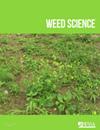高播率、行间刈割和电刑对有机免耕大豆杂草管理的影响
IF 2.5
2区 农林科学
Q2 AGRONOMY
引用次数: 0
摘要
免耕种植有机大豆[甘氨酸max (L.)]稳定。与传统的以耕作为基础的有机生产相比,将玉米制成卷卷黑麦(Secale cereale L.)有几个优势。然而,在杂草丛生的田地中,黑麦生长不佳可能导致杂草抑制减少、杂草与作物竞争和大豆产量损失。生态杂草管理理论认为,将多种管理措施整合起来,这些措施本身可能效果较弱,但它们共同提供了高水平的杂草抑制。在2021年和2022年,在纽约中部进行了一项田间试验,以评估在谷物黑麦覆盖和无覆盖的有机免耕大豆中单独实施和联合实施的三种杂草管理策略的效果:1)提高作物播种率,2)行间刈割,3)杂草电刑。还包括不进行任何杂草管理的未处理对照处理和无杂草控制处理。在重复试验的5块田地中,有2块没有谷物黑麦;然而,谷物黑麦的存在对结果没有不同的影响,因此数据是跨田汇总的。与未处理的对照相比,包括行间刈割在内的所有处理都使杂草生物量减少了至少60%,大豆产量增加了14%。与未处理对照相比,单独或联合使用高播种率或杂草电刑都没有改善杂草抑制或大豆产量。所有处理的大豆产量都比无杂草对照区至少低22%。未来的研究应该在较长一段时间内探索这些策略对杂草种群和群落动态的影响。还应研究行间刈割和杂草电杀的间接影响,如提高收获能力的潜力、降低杂草种子产量和生存力、对土壤生物和农业生态系统生物多样性的影响。本文章由计算机程序翻译,如有差异,请以英文原文为准。
High seeding rates, inter-row mowing, and electrocution for weed management in organic no-till planted soybean
No-till planting organic soybean [Glycine max (L.) Merr.] into rolled-crimped cereal rye (Secale cereale L.) can have several advantages over traditional tillage-based organic production. However, suboptimal cereal rye growth in fields with large populations of weeds may result in reduced weed suppression, weed-crop competition, and soybean yield loss. Ecological weed management theory suggests that integrating multiple management practices that may be weakly effective on their own can collectively provide high levels of weed suppression. In 2021 and 2022, a field experiment was conducted in central New York to evaluate the performance of three weed management tactics implemented alone and in combination in organic no-till soybean planted into both cereal rye mulch and no mulch: 1) increasing crop seeding rate, 2) inter-row mowing, and 3) weed electrocution. A nontreated control treatment that did not receive any weed management and a weed free control treatment were also included. Cereal rye was absent from two of the five fields where the experiment was repeated; however, the presence of cereal rye did not differentially affect results and thus data were pooled across fields. All treatments that included inter-row mowing reduced weed biomass by at least 60% and increased soybean yield by 14% compared to the nontreated control. The use of a high seeding rate or weed electrocution, alone or in combination, did not improve weed suppression or soybean yield relative to the nontreated control. Soybean yield across all treatments was at least 22% lower than the weed free control plot. Future research should explore the effects of the tactics tested on weed population and community dynamics over an extended period. Indirect effects from inter-row mowing and weed electrocution should also be studied, such as the potential for improved harvestability, decreased weed seed production and viability, and the impacts on soil organisms and agroecosystem biodiversity.
求助全文
通过发布文献求助,成功后即可免费获取论文全文。
去求助
来源期刊

Weed Science
农林科学-农艺学
CiteScore
4.60
自引率
12.00%
发文量
64
审稿时长
12-24 weeks
期刊介绍:
Weed Science publishes original research and scholarship in the form of peer-reviewed articles focused on fundamental research directly related to all aspects of weed science in agricultural systems. Topics for Weed Science include:
- the biology and ecology of weeds in agricultural, forestry, aquatic, turf, recreational, rights-of-way and other settings, genetics of weeds
- herbicide resistance, chemistry, biochemistry, physiology and molecular action of herbicides and plant growth regulators used to manage undesirable vegetation
- ecology of cropping and other agricultural systems as they relate to weed management
- biological and ecological aspects of weed control tools including biological agents, and herbicide resistant crops
- effect of weed management on soil, air and water.
 求助内容:
求助内容: 应助结果提醒方式:
应助结果提醒方式:


